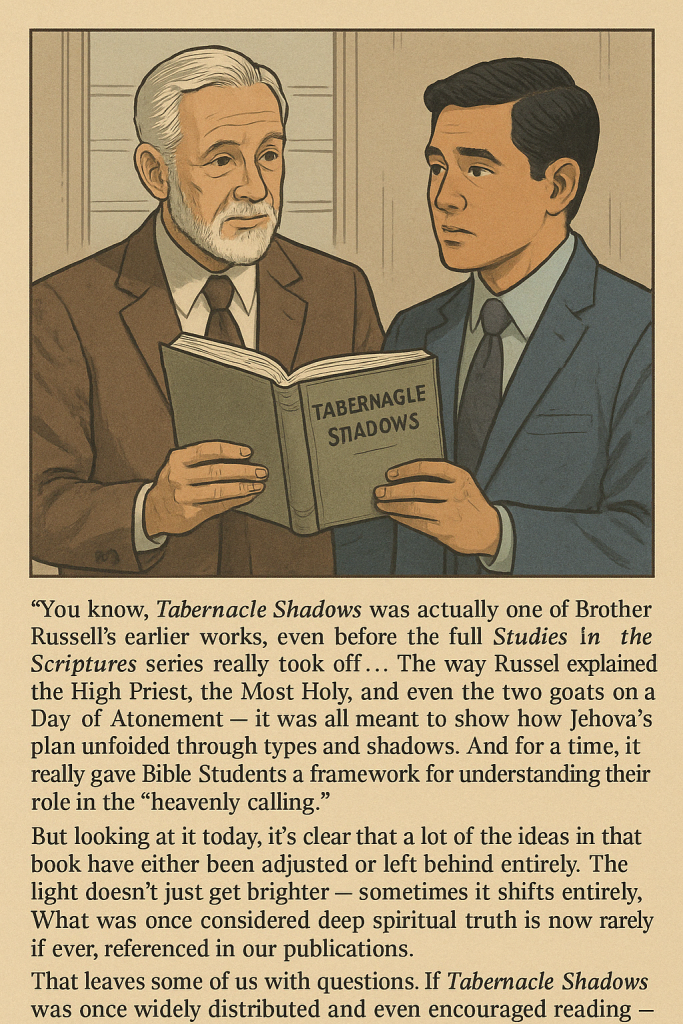
📘 Tabernacle Shadows of the Better Sacrifices (1881)
Charles Taze Russell’s Typological Study
🔹 Title:
Tabernacle Shadows of the Better Sacrifices
🔹 Author:
Charles Taze Russell
🔹 Publication Year:
1881
🔹 Purpose of the Book:
This book was designed to explain how the rituals of Israel’s tabernacle, the Levitical priesthood, and their sacrifices symbolically foreshadowed the redemptive work of Jesus Christ and the future heavenly priesthood class (the 144,000). Russell presented it as a “key” to understanding God’s overall plan of salvation and the deeper, hidden meanings of Scripture.
📜 Public Domain Use
Tabernacle Shadows of the Better Sacrifices, published by Charles Taze Russell in 1881, is in the public domain. Because it was published prior to January 1, 1929, and no copyright restrictions apply, it may be freely copied, shared, reformatted, and distributed without permission or royalty obligations.
🔍 Summary of Issues with the Book
Tabernacle Shadows of the Better Sacrifices was influential among early Bible Students, but it presents a number of theological and interpretive issues:
- Heavy reliance on speculative typology, with symbolic meanings not clearly supported in Scripture.
- Promoted a two-class salvation model (144,000 heavenly class and a secondary class) which was later modified or dropped.
- Emphasized symbolic rituals from the Old Testament while de-emphasizing direct New Testament teachings.
- Closely tied to Russell’s now-discarded prophetic framework, including expectations surrounding 1874 and 1914.
- No longer used or recommended by modern Jehovah’s Witnesses, indicating doctrinal obsolescence.
| # | Issue | Description |
|---|---|---|
| 1 | Speculative Interpretations | Typological interpretations are based on speculation rather than direct New Testament teachings. |
| 2 | Little Scriptural Basis for Two-Class System | The concept of a heavenly “Little Flock” versus a secondary class is loosely supported in Scripture and later changed in JW doctrine. |
| 3 | Obsession with Types and Shadows | Overemphasis on Old Testament symbolism sometimes overshadows clear Gospel teachings. |
| 4 | Reinforces Failed 19th Century Eschatology | The book is tied to Russell’s prophetic framework including the incorrect 1874 and 1914 expectations. |
| 5 | Later Revisions in JW Doctrine | Teachings in this book are no longer supported or taught by Jehovah’s Witnesses today, showing doctrinal shifts. |
Final Thoughts
You know, Tabernacle Shadows was actually one of Brother Russell’s earlier works, even before the full Studies in the Scriptures series really took off. Back then, it was used almost like a primer — something to help brothers and sisters understand the deeper symbolic meanings behind the Mosaic tabernacle and sacrifices. The way Russell explained the High Priest, the Most Holy, and even the two goats on the Day of Atonement — it was all meant to show how Jehovah’s plan unfolded through types and shadows. And for a time, it really gave Bible Students a framework for understanding their role in the “heavenly calling.”
But looking at it today, it’s clear that a lot of the ideas in that book have either been adjusted or left behind entirely. For instance, the sharp focus on a two-class salvation — the “Little Flock” versus a secondary group — doesn’t fully match what we now understand about the “great crowd” and Jehovah’s purpose for faithful ones on earth. And the strong emphasis on Old Testament symbols sometimes came at the expense of clearer Christian truths that are laid out in the Gospels and the letters.
It’s not to say that the book wasn’t sincere or helpful in its time — it definitely served a purpose for the brothers and sisters back then. But it’s also a reminder of how much our understanding has changed over the years. The light doesn’t just get brighter — sometimes it shifts entirely. What was once considered deep spiritual truth is now rarely, if ever, referenced in our publications.
That leaves some of us with questions. If Tabernacle Shadows was once widely distributed and even encouraged reading — but is now essentially set aside — how should we think about the other teachings we accept today as “present truth”? Can we be sure they won’t be quietly replaced someday too? It’s something worth meditating on, especially when we’re taught that Jehovah is the one directing His organization.
1874 second coming 1881-publication 1977-publication 1995-yearbook ancient-worthies bible student movement charles-t-russell-era charles-taze-russell doctrinal-changes doctrinal-shift doctrinal-shifts doctrinal-transition early-watchtower early jehovah's witnesses end-times-messaging eschatology failed-prophecies fred-franz governing-body-control great-crowd-shift incoming-world-government invisible-return-1874 joseph-f-rutherford jw-books jw-history jw doctrine changes jw vs bible students knorr-era millennial-dawn no-1975-mention no-hellfire no-trinity obedience-to-organization old-light organization-loyalty post-1975 post-1975-to-1994-era post-rutherford public domain theology pyramidology pyramid prophecy rutherford-era rutherfords-death-to-1975-era studies in the scriptures watchtower origins
